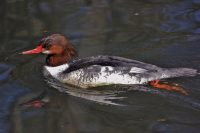Winter Birding: The Common and the Uncommon
By Brian Kluepfel

It’s a funny thing, the naming of birds. Some names seem to fit perfectly, like the Scarlet Ibis or the Snowy Owl, while others don’t make as much sense. There’s the Red-bellied Woodpecker: you’d be hard-pressed to find any red on their breast. And the Common Merganser: while they may be plentiful, there is nothing really common about this aquatic bird.
Last week, in the midst of a rather awful work day, I took a short drive over to the Tarrytown Lakes. Taking a bumpy exit off the serpentine road, I walked to the metal border fence and spied some mergansers (“common mergs” in the birding world) in my binocular.
This is an uncommonly beautiful bird. The Cornell Lab describes them as a “streamlined duck” and I can think of no better designation. Male Common Mergansers are white, with a dark green head and a thin, bright red-orange bill. Often in the bird world, males take the cake in terms of good looks, but the female common merg is a spectacle herself: cinnamon-brown head with white chin and a Sid Vicious crest, atop a grey body.
I was shivering in my dress coat, and steamy breath issued from my mouth as I looked at a flock of about 40 common mergs. The closer I crept, the more special these birds appeared. But honestly, I had a short break from work and I was cold. I dashed back to the car and was back in the salt mines of technology in about 10 minutes.
It only took those few moments to shake off the effect of a disagreeable day. Birds are everywhere, and the more attuned we become to their presence, the more we see and recognize. For me, this fun multiplies with the more I learn and the more expert birders I hang out with. For example, just days after my fowl experience, I stopped near the same point and met a fellow birder with a powerful spotting scope, who pointed out not only mergs, but an individual Common Loon among the flock. (Insert joke about lone loon here.)
Birding can be rewarding at all levels of experience, which is why – drum roll please – each year the Cornell Lab of Ornithology conducts the Great Backyard Bird Count (GBBC).
GBBC is, like the annual Christmas Counts, an example of citizen science that allows birders of any age to contribute to our collective knowledge. Tracking birds is one way of observing changes to our planet that may also affect us humanoids. On a lighter note, keeping a list with your kids or your partner is a fun way to spend part of a morning, and you never have to leave your home.
You could make it a friendly competition among friends or classmates – or the beginning of a cool science project for school. You might try to photograph the more interesting avian visitors. You may even discover species you never knew existed in your own backyard. (You can also do similar armchair birding at the Croton Nature Center’s Project Feeder Watch, from 9 to 11 a.m. Saturdays and Sundays.)
So, this weekend, stock up your feeders and linger over your coffee, tea, cookies and scones and jot down what you see. Maybe it will be the first page of entries on your life list of birds.
Brian Kluepfel is a longtime birder and board member of the Saw Mill River Audubon. He’s authored guidebooks throughout South America for Fodor’s and Lonely Planet, and also blogs on nature at brianbirdwatching.wordpress.com. For local birding events, check out www.sawmillriveraudubon.org.

Examiner Media – Keeping you informed with professionally-reported local news, features, and sports coverage.
